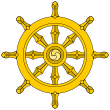
The Tuvan People's Republic or TPR; known as the Tannu Tuva People's Republic until 1926, was a partially recognized state that existed between 1921 and 1944. It was formally a socialist republic and de facto a Soviet puppet state. The TPR was located in Tuva, covering the same territory, north-west of Mongolia, as was the previous 1914–1921 Tuvan protectorate of the former Russian Empire, and is now the Tuva Republic, an administrative part of Russia.

Tuva or Tyva, officially the Republic of Tuva, is a republic of Russia. Tuva lies at the geographical center of Asia, in southern Siberia. The republic borders the Altai Republic, Khakassia, Krasnoyarsk Krai, Irkutsk Oblast, and Buryatia in Russia, and shares an international border with Mongolia to the south. Tuva has a population of 336,651. Its capital is the city of Kyzyl.
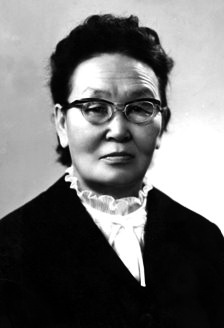
Khertek Amyrbitovna Anchimaa-Toka was a Tuvan and Soviet politician who in 1940–44 was the Chairwoman of Little Khural of the Tuvan People's Republic, and the first non-royal female head of state. She was the wife of Salchak Toka, who was the republic's supreme leader from 1932 to 1973.
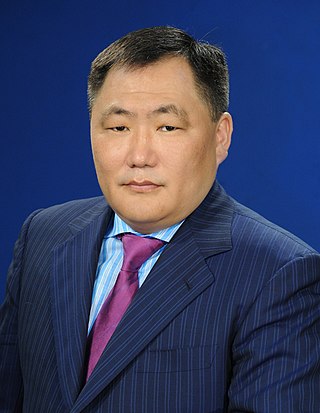
Sholban Valeryevich Kara-ool is a Russian politician of Tuvan ethnic origins. He was the Head of the Republic of Tuva, a Russian republic.
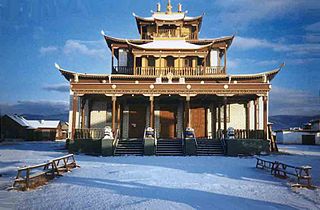
Historically, Buddhism was incorporated into Siberia in the early 17th century. Buddhism is considered to be one of Russia's traditional religions and is legally a part of Russian historical heritage. Besides the historical monastic traditions of Buryatia, Tuva and Kalmykia, the religion of Buddhism is now spreading all over Russia, with many ethnic Russian converts.
"Men – Tyva men" is the regional anthem of the Republic of Tuva, a federal subject of Russia. It was composed by Kantomur Saryglar, and the lyrics were written by Okey Shanagash. It was adopted officially by the Great Khural on 11 August 2011, replacing the previous anthem Tooruktug Dolgay Tangdym.

Aldyn-ool Takashovich Sevek was a master Tuvan throat singer.
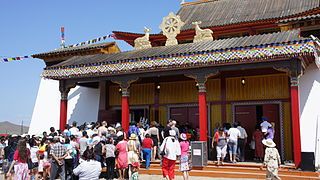
Chadan is a town and the administrative center of Dzun-Khemchiksky District in the Tuva Republic, Russia, located on the Chadan River, 224 kilometers (139 mi) west of Kyzyl, the capital of the republic. As of the 2010 Census, its population was 9,035. The Russian Defense Minister Sergei Shoigu was born in Chadan.

The 1929 Tuvan coup d'état took place in the Tuvan People's Republic. It occurred in January after the Tuvan government under Prime Minister Donduk Kuular attempted to implement nationalist, religious and anti-Soviet policies, including making Tibetan Buddhism the official religion. With support from the Soviet Union, five Tuvan youths successfully overthrew the government, and one of them, Salchak Toka, became supreme ruler as General Secretary of the Central Committee of the Tuvan People's Revolutionary Party. They quickly reversed Donduk's policies and brought the republic closer to the Soviet Union. The Tuvan People's Republic later joined the Soviet Union in 1944.

Saidash Begzy Oglu Mongush is a Tuvan folk musician from Kyzyl known for his throat singing performance. He is associated with the Tuvan rock band Yat Kha and the folk group Huun Huur Tuu.

Uryankhay Krai was the name of what is today Tuva and was a short-lived protectorate of the Russian Empire that was proclaimed on 17 April 1914, created from the Uryankhay Republic which had recently proclaimed its independence from the Qing dynasty of China in the Mongolian Revolution of 1911. After the February Revolution and abdication of Tsar Nicholas II, Uryankhay Krai recognized the new Russian Republic and reaffirmed its status as a Russian protectorate in 1917.

The Tuvan People’s Republic entered World War II on the side of the Allied Powers, shortly after the invasion of the Soviet Union by Nazi Germany, breaking the non-aggression pact between the Soviet Union and Third Reich.

Jampel Lodoy, also spelled with variations of Dzhampel Lodoi or Jambal Lodoi, was a Russian Tuvan Buddhist lama who served as the Kamby Lama of Tuva for two tenures. The Kamby Lama, or Supreme Lama, is the highest Buddhist religious authority in Tuva. Jampel Lodoy was first elected Kamby Lama from 2005 to 2010. During the 2010s, Jampel Lodoy became the abbot of Ustuu-Khuree, one of the largest Buddhist monasteries and temples in Tuva, which had been destroyed in 1937, but reopened in 2012.

The Tuvan People's Revolutionary Army (TNRA) (Russian: Тувинская народно-революционная армия; Tuvan: Тываның Араттың Революстуг Шерии) was the military wing of the Tuvan People's Revolutionary Party which constituted the armed forces of the Tuvan People's Republic.

Kidispey Dagbaevich Choodu was an aviation pioneer, flight instructor, and the first Tuvan pilot.
Anarchism in Mongolia was present during the revolutionary period of the 1910s and 1920s, closely linked with the Russian anarchist movement in Altai, Buryatia and Tuva.
The 2021 Republic of Tuva head election took place on 17–19 September 2021, on common election day, coinciding with election to the State Duma. Acting Head Vladislav Khovalyg was elected for his first full term.
Mikhail Sergeyevich Kozlov, is a Russian statesman who was the acting Governor (Head) of Altai Krai in August 2005.

Chylgychy Chimit-Dorzhuyevich Ondar was a Russian politician of Tuvan ethnicity. From 2001 to 2007, Ondar was a member of the State Duma. He was a member of United Russia.

Kuzhuget Sereyevich Shoigu, born Shoigu Sereyevich Kuzhuget was a Soviet Tuvan politician, journalist, and writer who served as a secretary of the Tuvan Regional Committee of the Communist Party of the Soviet Union, first Deputy Chairman of the Council of Ministers of the Tuvan Autonomous Soviet Socialist Republic, and a deputy of the Supreme Soviet of the Tuvan ASSR. He was also the father of Sergei Shoigu and Larisa Shoigu.
